I currently have a method which queries a database for values, and plots them to a graph. The only problem is, the time variable is a long, and results in my graph looking like this:

I want to convert it to a date format and then add it to the graph.
How can I do this?
Here is my graph code:
private Long time;
private Long intensity;
public XYSeries series = new XYSeries("Sensor");
private XYDataset xyDataset;
public JFreeChart chart;
xyDataset = new XYSeriesCollection(series);
chart = ChartFactory.createXYLineChart("Sensor Data", "Time", "Intensity", xyDataset, PlotOrientation.VERTICAL, true, true, false);
Here is my method for adding to the graph:
public void GetDustLevels() {
series.clear();
try {
currentSensor = Application.getInstance().getMinesite().getSensors().get(sensorID);
} catch (Exception e1) {
e1.printStackTrace();
}
if (currentSensor != null) {
sensorKDTree = currentSensor.getSensorData();
Iterator<Map.Entry<GenericPoint<Long>, String>> allPoints = sensorKDTree.iterator(sensorKDTree.getMin(null), sensorKDTree.getMax(null));
while (allPoints.hasNext()) {
GenericPoint<Long> timeIntensityPair = allPoints.next().getKey();
time = timeIntensityPair.getCoord(0);
intensity = timeIntensityPair.getCoord(1);
System.out.println("CURRENT SENSOR" + currentSensor);
System.out.println("TIME: " + time + " " + "INTENSITY: " + intensity);
series.add(time, intensity);
}
}
}
Any help would be GREATLY appreciated! Thank you!
EDIT: I have changed my code to this:
public TimeSeries series = new TimeSeries("Sensor", Date.class);
public JFreeChart chart;
private Long time;
private Long intensity;
TimeSeriesCollection xyDataset = new TimeSeriesCollection(series);
chart = ChartFactory.createTimeSeriesChart("Sensor Data", "Time", "Intensity", xyDataset, true, true, false);
And my new GetDustLevels() method:
public void GetDustLevels() {
series.clear();
try {
currentSensor = Application.getInstance().getMinesite().getSensors().get(sensorID);
} catch (Exception e1) {
e1.printStackTrace();
}
if (currentSensor != null) {
sensorKDTree = currentSensor.getSensorData();
Iterator<Map.Entry<GenericPoint<Long>, String>> allPoints = sensorKDTree.iterator(sensorKDTree.getMin(null), sensorKDTree.getMax(null));
while (allPoints.hasNext()) {
GenericPoint<Long> timeIntensityPair = allPoints.next().getKey();
time = timeIntensityPair.getCoord(0);
intensity = timeIntensityPair.getCoord(1);
System.out.println("CURRENT SENSOR" + currentSensor);
System.out.println("TIME: " + time + " " + "INTENSITY: " + intensity);
XYPlot plot = (XYPlot) chart.getPlot();
DateAxis axis = (DateAxis) plot.getDomainAxis();
axis.setDateFormatOverride(new SimpleDateFormat("dd-MMM-yyyy"));
series.add(new Date(time.longValue()), intensity);
}
}
}